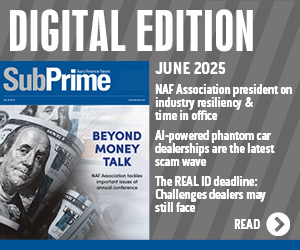Great Recession repeat not expected as payment performance likely softens

As experts and policymakers shared a variety of economic trend updates and observations, Fitch Ratings summarized that record-setting payment performance isn’t likely to simply last forever.
But at the same time, Fitch reiterated that deterioration of auto finance performance — especially in the subprime space — won’t pull the entire economy into a tailspin like some pontificators keep trying to allege.
In analysis released this week, Fitch acknowledged the continued financial resilience of the U.S. consumer has prolonged a period of “extremely strong” asset quality among many U.S. consumer lending segments. However, analysts insisted that U.S. consumer loan losses at financial institutions are at “unsustainable” cyclical lows and a more meaningful amount of credit deterioration should be expected over the near to medium term.
“This will particularly be the case should unemployment claims begin to reverse after reaching multi-decade lows,” Fitch said.
A month after the rate tied a 10-year low, S&P Dow Jones Indices and Experian released data through June on Tuesday and determined auto loan defaults decreased 3 basis points from the previous month to settle at a new low mark of 0.82 percent. The May reading had tied for the lowest mark analysts have seen during the past 10 years. In June 2015, the auto finance default rate also stood at 0.85 percent.
The new low record might not last, as the rate has made an upward movement from June into July during five of the past eight years. The most pronounced rise in the cyclical pattern arrived in the immediate aftermath of the Great Recession, when the rate in June 2009 of 2.18 percent jumped to 2.46 percent a month later.
Fitch explained the extent to which weaker credit performance will be a challenge for individual consumer lenders and finance companies will vary depending on the diversity of their activities and the extent to which they have strengthened capital and loss reserves to absorb higher losses. Analysts added their willingness to tighten underwriting standards in recent quarters in anticipation of a weaker macroeconomic environment will also be a key factor.
“Reflecting these dynamics, Fitch believes diversified banks are better positioned than mono-line lenders to weather meaningful erosion in consumer asset quality,” analysts said.
Fitch also pointed out that credit cards and auto loans — particularly retail credit cards and subprime vehicle installment contracts — will be the consumer loan segments most likely to see asset quality deterioration in the near to medium term. The firm noted higher loss rates and delinquencies have already begun to materialize.
“Drivers of weaker credit performance include stronger loan growth in recent years, increased competition leading to looser underwriting standards in the post-financial crisis period (including greater exposure to subprime borrowers) and, in the case of auto lending, residual values that have been supported by unsustainably high used vehicle prices,” analysts said.
According to Federal Reserve surveys, banks have begun tightening underwriting standards in both segments over the past several quarters.
“The potential systemic impacts of a rapid deterioration in either credit card or auto lending are limited relative to pre-crisis residential mortgage lending,” Fitch said. “Both segments are much smaller than residential mortgage debt with shorter loan durations and smaller loan balances.”
Ability to maintain payments
While Fitch referenced the impact unemployment might have on consumers’ ability to maintain their debt commitments, the latest analysis from Comerica Bank took a closer look at the latest federal employment report that indicated payroll employment increased by 222,000 net jobs in June.
Comerica Bank mentioned that revised figures for April and May triggered the unemployment rate to tick up slightly to 4.4 percent.
“This is not a sign of a cooling labor market. We expect that labor market conditions will continue to tighten through the second half of this year,” Comerica Bank chief economist Robert Dye said in the commentary.
Comerica also mentioned the average workweek inched up by one tenth of an hour to 34.5, and average hourly earnings increased moderately by 4 cents, or 0.2 percent.
“So this labor report hit the trifecta, showing that more workers worked longer hours and got paid more for it,” Dye said. “This is supportive of income growth in June and beyond and consumer spending, too.”
Comerica Bank maintained that despite this labor market data, the Federal Reserve is likely to leave interest rates where they currently are at 1.25 percent when the Federal Open Market Committee meets beginning on Tuesday. Dye is also projecting that the Fed will announce the beginning of balance sheet reduction at its September meeting and that another 0.25 interest rate rise should come in December.
During her semiannual appearance before the House Financial Services Committee, Federal Reserve chair Janet Yellen reiterated the strategy policymakers plan to leverage.
“The committee continues to expect that the evolution of the economy will warrant gradual increases in the federal funds rate over time to achieve and maintain maximum employment and stable prices,” Yellen said in her prepared testimony. “That expectation is based on our view that the federal funds rate remains somewhat below its neutral level — that is, the level of the federal funds rate that is neither expansionary nor contractionary and keeps the economy operating on an even keel.
“Because the neutral rate is currently quite low by historical standards, the federal funds rate would not have to rise all that much further to get to a neutral policy stance,” she continued. “But because we also anticipate that the factors that are currently holding down the neutral rate will diminish somewhat over time, additional gradual rate hikes are likely to be appropriate over the next few years to sustain the economic expansion and return inflation to our 2 percent goal.
“Even so, the committee continues to anticipate that the longer-run neutral level of the federal funds rate is likely to remain below levels that prevailed in previous decades,” Yellen went on to say.
And with regard to rate hikes the Fed already made, TransUnion’s analysis showed that most borrowers were able to absorb their increased monthly payment obligations after the Fed’s rate hike last December.
TransUnion’s study identified these 63 million consumers because they carried debts for which the minimum monthly payment due was tied to the market interest rate, such that a rise in rates from the December rate hike could cause an increase in payments required. TransUnion used its CreditVision aggregate excess payment (AEP) algorithm, which incorporates monthly payments from mortgages, credit cards and other debt obligations, to identify 10.6 million of these consumers who were at elevated risk of not having the capacity to absorb a rate increase of 0.25 percent.
The study then tracked the performance of these consumers through the end of March to give the December rate increase enough time to affect payment obligations. The study found that, in fact, only 1 million of these consumers were delinquent at the end of March. This was slightly lower than the study’s control group, who had no variable-rate products.
TransUnion explained this result implies that consumers with variable-rate credit were able to manage the rate increase as well as, or better than, consumers without variable-rate products.
“When we announced our ‘capacity to absorb a rate increase’ metric last May we said that it was a conservative measure of risk, in that it did not account for contributions to savings or investments that could be reallocated to cover debt service increases,” said Ezra Becker, senior vice president of research and consulting at TransUnion.
“We described our metric as an upper bound on the number of consumers who would struggle with a rate increase,” Becker continued. “We’re pleased to see that only 10 percent of those consumers we had considered at elevated risk of payment shock from a rate increase exhibited delinquency over the study period. Most consumers appeared able to reallocate their available cash, or make small changes to their spending habits, to effectively absorb the December rate increase.”
More about the overall economy
Fitch is maintaining its view that U.S. GDP growth will rise in 2017 and 2018.
“Increases in interest rates unaccompanied by meaningful economic growth and expanding wages could pressure consumer asset quality as it would result in increased debt service (for floating-rate obligations) and elevated refinancing risk without the benefit of higher income to absorb these costs,” analysts said.
“We believe that recent Fed rate hikes are part of long-term monetary policy normalization that is aligned with current macroeconomic conditions and the outlook,” they continued.
In the first quarter, Fitch mentioned U.S. consumer debt returned to its pre-crisis peak of $12.7 trillion after falling to a post-crisis low of $11.2 trillion in 2Q13. The student loan and auto segments have had the most pronounced increases, although credit card debt has also accelerated recently.
Between Q4 2008 and Q1 2017, Fitch calculated that student loan debt more than doubled to $1.3 trillion while auto finance balances increased by 48 percent to $1.2 trillion.
Over the same period, Fitch added that the much larger mortgage component of consumer debt declined by 6.8 percent to $8.6 trillion from a peak of $9.3 trillion, reflecting substantially tighter underwriting amid increased regulation and the exit of many non-bank lenders.
“Looking ahead, my colleagues on the FOMC and I expect that, with further gradual adjustments in the stance of monetary policy, the economy will continue to expand at a moderate pace over the next couple of years, with the job market strengthening somewhat further and inflation rising to 2 percent,” Yellen told House lawmakers.
“This judgment reflects our view that monetary policy remains accommodative,” she continued. “Ongoing job gains should continue to support the growth of incomes and, therefore, consumer spending; global economic growth should support further gains in U.S. exports; and favorable financial conditions, coupled with the prospect of continued gains in domestic and foreign spending and the ongoing recovery in drilling activity, should continue to support business investment.
“These developments should increase resource utilization somewhat further, thereby fostering a stronger pace of wage and price increases,” Yellen added.


